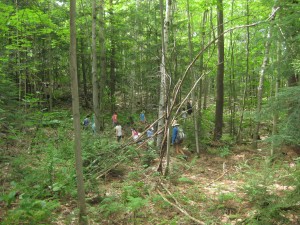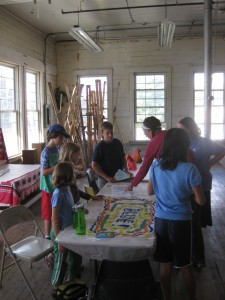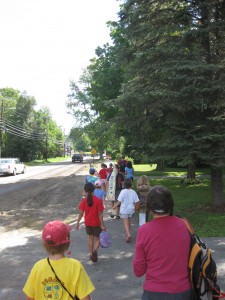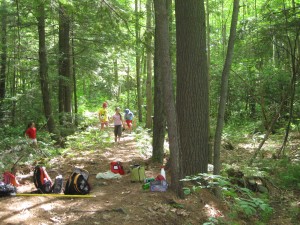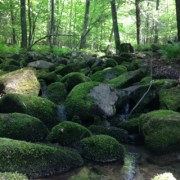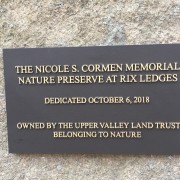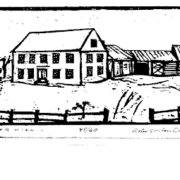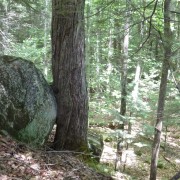Local Art in the Wild Camp Encourages Children to Find Inspiration: Naturally
At the beginning of the month, children got a chance to experience nature, and art, on their own terms. The AVA Gallery, in partnership with the Vermont Institute of Natural Science (VINS), hosted a brand new program that they called Art in the Wild – A New Summer Art Camp Experience. AVA utilized their own studio space in Lebanon, NH as well as the City’s recently-conserved Jackson Conservation Area to give children ages 6 to 13 special places to explore and respond to the natural world.
I visited the camp mid-way through the one week camp session, and spent the morning with eleven children in the 10 to 13 year old group. As a staff member of UVLT, I was interested to see how a property conserved for public use was functioning in that role. Some people might think conserving property for public enjoyment serves only a passive role. AVA’s Art in the Wild stood as a unique example of both the energy that public enjoyment can embody as well as the educational benefit of permanently protecting a public natural area.
I arrived during check-in and exuberant campers of all ages rushed to greet their newfound friends as their parents signed them in. The room was filled with the chatter of small voices punctuated by the loud snap of “poppersâ€- a folded paper object that the campers made earlier in the week using origami techniques. Triangular in shape, the poppers were held by a corner and with the jerk of a wrist the paper deployed itself with a satisfying crack resembling that of a flag caught in the wind. I was struck that in this small sliver of time, unprompted, the kids seized the chance to keep creating. Soon paper airplanes filled the air in joyful creative chaos.
Once everyone arrived, the two age groups disbanded to different studios for a brief outline of the morning’s activities. For my group it was an intense planning session for the game ‘capture-the-flag’. Longtime educator, artist, and AVA staff member, Murray Ngoima, explained to me that each day was structured similarly. Mornings were spent outside on the conserved land, and afternoons allowed the campers time in the studio to respond to the first part of their day. Each day’s activities built a little on top of the day before. For example, the first day started with an exploration of the conserved land including use of compasses and maps showing the boundary of the property. Today, with bragging rights and glory on the line, the children would use the same maps and their new-found familiarity with the land to plan their flag hiding strategy.
Once it appeared that everyone was satisfied with their scheme, preparations began for our exit to the woods. Each child was reminded to bring a snack, water, and wear bug repellant, and with a flurry of lunchboxes and aerosol cans, we were off!
The Jackson Conservation Area is located on the eastern edge of downtown Lebanon, an easy 15 minute walk from the AVA Gallery. Purchased by the city, the nearly 16 acre area is primarily forested but also contains nearly three acres of open fields. The property has a history of public use by neighbors and other community members who walk the trails and enjoy recreating in the fields. The previous owners welcomed this public access and are pleased that its permanent protection by the City of Lebanon ensures residents can continue to benefit from this natural area.
The kids located the trail, and we made our way up the hill single-file to the designated capture-the-flag battleground; the moment had come for me to see everything in action. As the kids paused for drinks and a snack, Murray, along with AVA class assistant, Galen Richardson, and VINS staff member, Lyndsay Bushey-Hesselbach, reviewed some key ground rules, namely the boundaries for the playing field and where ‘safety zones’ existed for each team.
“Everyone in this game wins,†Murray reminded her audience, “we must try to do no damage to each other or the woods. We must take care of each other and the forest.â€
And with that advice, the game began! Nearly two hours passed as the evenly matched Blue and Red teams pitted their wits and sprinting ability against each other. Only a few pauses were enforced, once for Blue to relocate their flag – it was inaccessible at the top of a small sapling, once for the younger AVA campers to trek through the playing area, and lastly for a local woman to cross ‘neutral territory’ with her dog on their daily walk.
Overall, the game was fun-filled but some expressed disappointment about the outcome. A few disgruntled Blue players felt the flag relocation to be unfair, the Red team wanted a re-match, and there was even one team member who felt very strongly that he had been wronged by his own team. With a quiet authority, Murray soothed the discontent and the group agreed to a post-lunch discussion on the successes and shortcoming of the battle where all would have a chance to voice their feelings and opinions.
As we walked back toward the gallery, however, there was an overall feeling of camaraderie. Sporting a few scrapes but more smiles, the campers discussed future strategies. Murray took the chance to share a little more insight about the goals of the camp with me. From the beginning one could tell that it was not a typical summer camp, with teachers lecturing to their campers about art or nature. Instead, at Art in the Wild the educational moments came organically through the activities and interactions that the children were exposed to throughout the day. If questions arose or something occurred there would be a pause for discussion and collaboration, with both children and adults sharing their knowledge. Likewise, upon returning to the studio in the afternoon, there would not necessarily be a prescribed project for the kids to do to coincide with the day’s nature lesson. Rather, the children could explore their own personal reflection on their experiences using a variety of art media they had available to them.
In fact, one child had found a knotted piece of wood that looked like a woodpecker’s head and back in the studio she could let her imagination guide her, whether it was to paint it, create a sculpture, or craft another undefined art form of her choosing. And that was the whole idea: to allow children to experience art and nature on their own terms (with a little guidance along the way).
With Art in the Wild, the AVA Gallery and VINS have hosted a unique program for local children to explore art and experience nature right in town. It was exciting to see this educational opportunity first-hand, and know that it was a product of many forward thinking decisions and partnerships. I also can’t think of a truer and more vibrant example of the term ‘public use’. The collaboration between the Upper Valley Land Trust and folks like the Jacksons with entities such as the City of Lebanon and their Conservation Commission is crucial for this type of opportunity to exist on conserved lands; and more do exist, so get out there and enjoy them!
Anna Slack
Programs Coordinator, UVLT

